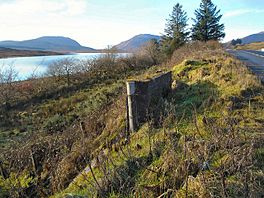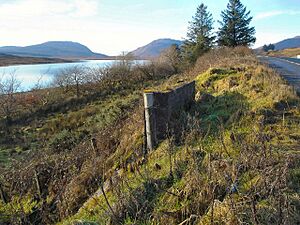Lough Mourne (Donegal) facts for kids
Quick facts for kids Lough Mourne |
|
|---|---|

With Barnesmore Gap in background
|
|
| Location | County Donegal |
| Coordinates | 54°45′1″N 7°54′2″W / 54.75028°N 7.90056°W |
| Lake type | reservoir |
| Native name | Loch Moirne Error {{native name checker}}: parameter value is malformed (help) |
| Primary outflows | Mourne Beg River |
| Catchment area | 8.87 km2 (3.4 sq mi) |
| Basin countries | Ireland |
| Max. length | 1.7 km (1 mi) |
| Max. width | 0.5 km (0.3 mi) |
| Surface area | 0.67 km2 (0.26 sq mi) |
| Average depth | 3.9 m (13 ft) |
| Max. depth | 11.9 m (39 ft) |
| Surface elevation | 168 m (551 ft) |
Lough Mourne (which means Loch Moirne in Irish) is a beautiful freshwater lake. You can find it in the northwest part of Ireland. It is located in County Donegal, very close to the border with County Tyrone.
Contents
Where is Lough Mourne located?
Lough Mourne is about 9 kilometers (5.6 miles) southwest of Ballybofey. It is also near the N15 road, making it easy to reach. This lake is very important because it acts as a reservoir. A reservoir is like a big storage tank for water. It supplies drinking water to Donegal Town.
Rivers connected to Lough Mourne
Several rivers flow into and out of Lough Mourne. The Mourne Beg River starts at the southern end of the lake. Another river, the Burn Daurnett, flows out from the north-eastern side. The Red Burn, also known as the Sruhanderg, flows into the western part of the lake.
What animals live in Lough Mourne?
Lough Mourne is home to many different kinds of fish. You can find roach, pike, and brown trout here. The lake is also home to the European eel, which is a critically endangered species. This means it is very important to protect them.
Protecting nature around the lake
The southwestern shore of Lough Mourne is a special place. It is part of the Croaghonagh Bog Special Area of Conservation. This area is protected to help keep its natural environment safe. It provides a home for many different kinds of wildlife. This includes important bird species that rely on the bog for their survival.



